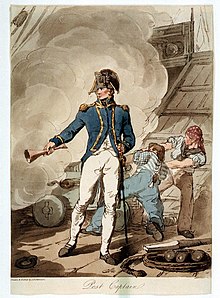Post-captain
This article needs additional citations for verification. (May 2016) |

| Naval officer ranks |
|---|
| Flag officers |
|
| Senior officers |
|
| Junior officers |
Post-captain, post captain, or postcaptain is an obsolete alternative form of the rank of captain in the Royal Navy.
The term served to distinguish those who were captains by rank from:
- Officers in command of a naval vessel, who were (and still are) addressed as captain regardless of rank;
- Master and Commander or the fictional Captain Horatio Hornblower in Hornblower and the Hotspur); this custom is now defunct.
In the Royal Navy of the 18th and 19th centuries, an officer might be promoted from commander to captain, but not have a command. Until the officer obtained a command, he was "on the beach" and on
A junior post-captain would usually command a
Sometimes, a high-ranking admiral would have two post-captains on his flagship. The junior would serve as the flag captain and retain responsibility for the day-to-day operation of the vessel. The senior would be the fleet captain, or "captain of the fleet", and would serve as the admiral's chief-of-staff. These two captains would be listed in the ship's roll as the "second captain" and "first captain", respectively.
After 1795, when they were first introduced on Royal Navy uniforms, the number and position of epaulettes distinguished between commanders and post-captains of various seniorities. A commander wore a single epaulette on the left shoulder. A post-captain with less than three years' seniority wore a single epaulette on the right shoulder, and a post-captain with three or more years seniority wore an epaulette on each shoulder.[citation needed] In the O'Brian series, Aubrey "wets the swab" – that is, he celebrates his promotion to commander and the acquisition of his "swab" or epaulette with the consumption of copious amounts of alcohol.
The term post-captain was descriptive only. It was never used as a title in the manner of "Post-Captain John Smith".
See also
- Rating system of the Royal Navy
- Post-ship
References
- London Gazette. Retrieved 2011-05-30.
